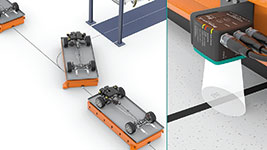

Image processing is one of the key technologies for the rationalisation of industrial systems and machines. This is because inductive or magnetic technologies are often used in the logistics area for driverless transportation systems. These result in higher costs, not only in terms of purchase price but also assembly effort. This task is solved much more elegantly with the new ‘PGV’ vision sensor, a compact all-inclusive system that specialises in the detection of colour tapes and data matrix codes.
Through the use of a coloured optical tape for driving, data matrix codes for positioning and control codes for manoeuvring, vehicle navigation has entered a new dimension. This unique combination is accomplished by the positioning system PGV Position Guided Vision – an optimal solution for the control of driverless transport systems.
Principle of operation
The system consists of a vision sensor, a colour tape and, if necessary, a data matrix band and/or control code. With this selection there are no more obstacles to the free navigation of an AGV (automated guided vehicle). The PGV with integrated lighting detects any colour route-tracking tape of a fixed or freely adjustable width. The value Y is sent to the vehicle controller, which is the value from the PGV to the centre of the tape. If an exact X-position is required in the application, a data matrix band can be stuck next to the route-tracking tape or directly onto it. An X-position, absolute position along the route-tracking tape, offers the possibility of installing stop positions, machining positions, transfer positions or park positions in the navigation system. Through the high resolution of the system, a robot, for example, can load or unload an AGV independently.
In most applications a ring will suffice as the route, but branches and crossovers must often be driven. To enable the vehicle controller to find the correct route, it is advisable to stick a control code in front of a branch. This indicates on the one hand a specific branch in the layout, and on the other a certain position. If the PGV detects a control code it transmits the control code number plus the position of Y.
The X, Y data and control code number alone are the most important data that is generally transmitted. The user is also given the angle, i.e. how the PGV is positioned above the route. When using the data matrix band, the user is also given the speed, and also generally status messages on the current network performance of the system.
If one route is not enough, a second one can be laid in parallel directly without adapting the PGV. In this case, all data is delivered twice (for two routes, etc.) to the vehicle controller.

Large reading window together with 2D image capturing detects damaged and dirty route-tracking tapes
With the camera system’s powerful, integrated signal processing, the X and Y position, the speed, the angle, and the operating status are accurately detected at all times and are continuously reported. The wide reading window can cope with any branches or crossovers, and even tight curves with precise position feedback at all times. Route-tracking tape interruptions and contamination are also tolerated, so there are no resulting limitations of any kind.
Reliable route tracking on coloured paint/tape strips, even on highly reflective surfaces
The PGV’s revolutionary camera technology makes it completely insensitive to ambient light. Dirty or damaged tapes or codes do not affect the PGV. Shiny floors, changing ambient light and strong light reflections interfere with conventional optical positioning systems, since they do not have a balanced selection of aperture, lens, and shutter speed. On the new PGV positioning system, the optical components are purely focused on the “region of interest” and the aperture and shutter speed are coordinated with optimum lighting. This means that the ambient light cannot impair the reading performance. The tape with user-defined width and colour no longer needs to be optically differentiated from the floor with contrast tape.
Compact housing fits into the smallest of AGVs
Whether in small or large vehicles, sufficient space for assembly is fundamental. The PGV sensor is always mounted underneath the vehicle with a direct view of the ground, as that is where the route-tracking tape is stuck. The optimal distance of 100 mm was deliberately chosen to allow enough ground clearance to avoid damaging nearby objects. Due to its compact housing measuring just 70 x 70 x 51 mm, the PGV offers every possible option in terms of tolerance, inclination, or tilt.
Easy installation and start-up with plug-and-play
With its superior hardware and software, the PGV delivers excellent process reliability, flexible handling and cost efficiency. The integrated universal interface to all standard fieldbuses and control systems enables the positioning system to be incorporated in accordance with the plug-and-play principle. In short, it is an ideal solution for automated guided vehicles in materials handling, the automotive industry, the print and paper industry, healthcare, and many other applications.
The sensor comes with a conventional serial RS-485 interface, the widely-used Profibus or CANopen interfaces, as well as the forward-looking Ethernet-based interfaces Profinet and Ethernet IP. Regardless of the interface selected, exactly the same output data is always available to the vehicle controller. Switching from one peripheral device to another is therefore easy and requires little effort.
Low material outlay and labour costs
Users do not need to concern themselves with the technical background. They are not confronted with complex vision technology, but benefit instead from the strengths of an advanced system. Consider reflections, for example: automatic exposure time control compensates for the different reflective properties and different colours of the substructure. On the basis of the PGV, positioning solutions operate with great accuracy regardless of the age and condition of the route-tracking tape, and are largely maintenance-free, as well as being immune to fault effects. The vision sensor even allows the use of any number of coloured route-tracking tapes – glued or painted.
For more information contact Mark Bracco, Pepperl+Fuchs, +27 (0)87 985 0797, [email protected], www.pepperl-fuchs.co.za
| Tel: | +27 10 430 0250 |
| Fax: | 086 756 8741 |
| Email: | [email protected] |
| www: | www.pepperl-fuchs.co.za |
| Articles: | More information and articles about Pepperl+Fuchs |
© Technews Publishing (Pty) Ltd | All Rights Reserved